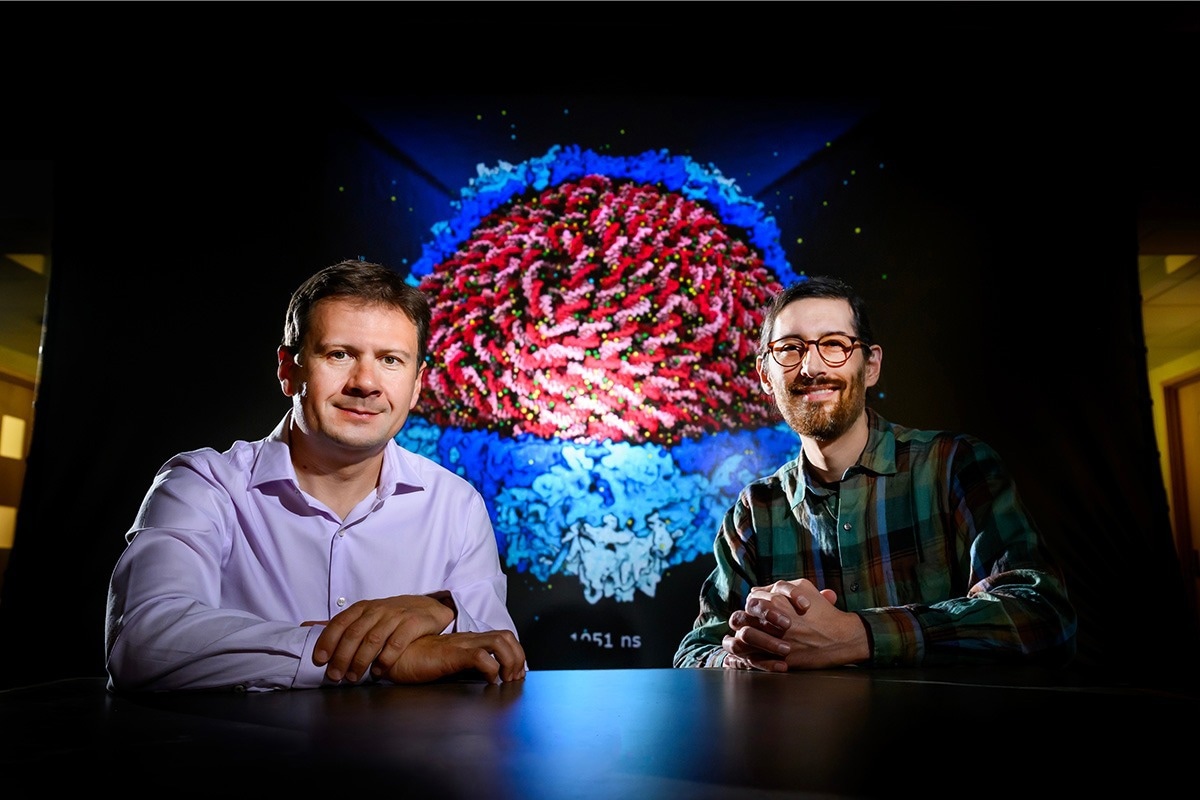Researchers at the University of Illinois Urbana-Champaign report that a computational model of the more than 26 million atoms in a DNA-packed viral capsid broadens the knowledge of virus structure and DNA dynamics, discoveries that potentially open up new research directions and therapeutic targets.
 The first atom-level model of a DNA-packed viral capsid reveals genome structure and possible new drug targets, University of Illinois researchers report. Pictured, from left: Physics Professor Aleksei Aksimentiev and Research Scientist Christopher Maffeo. Image Credit: Fred Zwicky
The first atom-level model of a DNA-packed viral capsid reveals genome structure and possible new drug targets, University of Illinois researchers report. Pictured, from left: Physics Professor Aleksei Aksimentiev and Research Scientist Christopher Maffeo. Image Credit: Fred Zwicky
The research was published in the journal Nature.
To fight a virus, we want to know everything there is to know about it. We know what is inside in terms of components, but we do not know how they are arranged, and knowledge of the internal structures gives us more targets for drugs, which currently tend to focus on receptors on the surface or replication proteins.”
Aleksei Aksimentiev, Study Leader and Professor, Department of Physics, University of Illinois
RNA or DNA is the genetic material that viruses store in a hollow particle known as a capsid. The structures of numerous hollow capsids have been identified, but the makeup of a complete capsid and its genetic material are still unknown.
The bacterium-infecting virus HK97 was the subject of the researchers’ first examination of a fully packaged viral genome. According to Aksimentiev, who is also connected to the Illinois Beckman Institute of Advanced Science and Technology, it has been thoroughly examined through experimentation, so the Illinois team can contrast its simulations with earlier findings.
Aksimentiev added, “We know from experiments that the capsid has a portal, and there is a motor protein there that pushes the DNA in. We also know the structure of the capsid from experiments. We know the genetic sequence, but what was not known was the structure of the packaged genetic material inside.”
Understanding the structural dynamics of genome packaging has proven difficult for scientists for several reasons. Since it cannot yet be observed experimentally, supercomputer simulation is needed. Still, a simulation can display much detail in a short amount of time or very little detail in a longer amount of time.
The Illinois team created a multiresolution approach to DNA simulation, examining the issue at various temporal and resolution scales and combining all the data to produce a more comprehensive picture of the procedure. Following its successful application and validation in DNA origami experiments, they have extended the multiresolution approach to HK97.
The outcome was the first atom-by-atom examination of the viral DNA packaging mechanism as well as the structural characteristics and variations when the DNA is completely enclosed within the capsid.
Switchback loops were formed by the DNA as it was pushed into the capsid, an important discovery because it resembles the organization of DNA in eukaryotic cells. Additionally, they discovered that the DNA arranged itself into domains that matched the capsid's topology. Each simulated particle's DNA topology and loop configuration varied slightly due to the process.
“These differences show that the concept of individuality is not exclusive to animals and plants but extends down to viruses, the most primitive form of gene-replicating structure an this opens another dimension to looking at infectivity, and whether these differences among viruses account for variability in their ability to infect,”Aksimentiev stated.
Common structural flaws and features were shown by the simulations, especially at the capsid’s corners and edges, where the shape of the structure affects the DNA inside the most. Aksimentiev stated that these characteristics might be possible targets for medication development.
Aksimentiev added, “We believe this is just the beginning for our methodology, the first study to look at the structure of a viral genome, and with bigger, faster computers, and more knowledge from experiments, we will eventually be able to computationally resolve the structures of genomes from other viral species, including RNA viruses, which are more complicated as they self-assemble.”
He concluded, “The more we know about these viruses, the more we can combat them, or harness them for applications such as combating bacteria that have grown resistant to antibiotic use.”
Source:
Journal reference:
Coshic, K., et al, (2024) The structure and physical properties of a packaged bacteriophage particle. Nature. doi.org/10.1038/s41586-024-07150-4